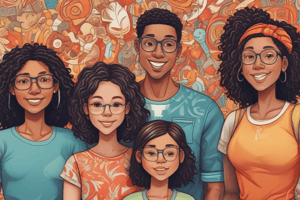Podcast
Questions and Answers
In the UK, what percentage of families were single-parent families in 1961?
In the UK, what percentage of families were single-parent families in 1961?
- 5%
- 15%
- 2% (correct)
- 10%
What is the main cause of the rise of reconstituted families?
What is the main cause of the rise of reconstituted families?
- Changes in immigration patterns
- Divorce and remarriage (correct)
- Increased cohabitation
- Rise of LGBTQ+ relationships
What is the most common type of single-parent family worldwide, in terms of the parent's gender?
What is the most common type of single-parent family worldwide, in terms of the parent's gender?
- Families headed by a single mother (correct)
- Families headed by a same-sex couple
- Families headed by a single father
- Families headed by multiple parents
According to the US Census Board, how many single-parent families were there in the USA in 2017?
According to the US Census Board, how many single-parent families were there in the USA in 2017?
What is the most likely outcome for custody of children in a divorce, according to the information provided?
What is the most likely outcome for custody of children in a divorce, according to the information provided?
What is the approximate percentage of families in the UK that were single-parent families in 2012?
What is the approximate percentage of families in the UK that were single-parent families in 2012?
Which of the following family forms is NOT directly attributed to the availability of divorce?
Which of the following family forms is NOT directly attributed to the availability of divorce?
Where are the lowest numbers of single-parent families headed by females found, according to the information provided?
Where are the lowest numbers of single-parent families headed by females found, according to the information provided?
What is a major factor contributing to assimilation of migrant groups into host societies?
What is a major factor contributing to assimilation of migrant groups into host societies?
What is the main reason for the growth of 'beanpole' families?
What is the main reason for the growth of 'beanpole' families?
What is the primary difference in family lifestyles between affluent and working-class families, as mentioned in the text?
What is the primary difference in family lifestyles between affluent and working-class families, as mentioned in the text?
Which of these is NOT a characteristic of the 'neo-conventional family' as defined by Chester?
Which of these is NOT a characteristic of the 'neo-conventional family' as defined by Chester?
How does the 'beanpole' family differ from previous generations in terms of family ties?
How does the 'beanpole' family differ from previous generations in terms of family ties?
Which of these is NOT an example of class diversity in family life, as discussed in the text?
Which of these is NOT an example of class diversity in family life, as discussed in the text?
Based on the text, which statement best describes Chester's view on the nuclear family in contemporary society?
Based on the text, which statement best describes Chester's view on the nuclear family in contemporary society?
Which of these is NOT a change that Chester acknowledges in the nuclear family over time?
Which of these is NOT a change that Chester acknowledges in the nuclear family over time?
What does the text suggest about the relationship between family diversity and cultural conflict?
What does the text suggest about the relationship between family diversity and cultural conflict?
What is the main idea that the author is trying to convey in the text?
What is the main idea that the author is trying to convey in the text?
What is the primary reason for the prevalence of blended families in industrialized societies?
What is the primary reason for the prevalence of blended families in industrialized societies?
What is the key difference between blended families and reconstituted families?
What is the key difference between blended families and reconstituted families?
Which of the following is NOT a challenge faced by reconstituted families, as identified by De'Ath and Slater (1992)?
Which of the following is NOT a challenge faced by reconstituted families, as identified by De'Ath and Slater (1992)?
What is the primary reason for the high number of single-person households in China?
What is the primary reason for the high number of single-person households in China?
What is the main argument presented by the text regarding the 'vertical extended family' structure?
What is the main argument presented by the text regarding the 'vertical extended family' structure?
What is the 'dual burden' faced by some women in dual-income nuclear families as discussed in the text?
What is the 'dual burden' faced by some women in dual-income nuclear families as discussed in the text?
What is the primary impact of global migration mentioned in the text?
What is the primary impact of global migration mentioned in the text?
Which of the following is a key argument made by Rhona and Robert Rapoport (1982) regarding family structures?
Which of the following is a key argument made by Rhona and Robert Rapoport (1982) regarding family structures?
Which of the following is NOT a factor contributing to the increase in single-person households?
Which of the following is NOT a factor contributing to the increase in single-person households?
What is the primary argument made by Wednesday Martin (2013) regarding step-families?
What is the primary argument made by Wednesday Martin (2013) regarding step-families?
What is the primary argument made by Daisy Guo (2017) regarding single-person households in China?
What is the primary argument made by Daisy Guo (2017) regarding single-person households in China?
Why are single-person households less common in less industrialized societies compared to industrialized societies?
Why are single-person households less common in less industrialized societies compared to industrialized societies?
Which of the following is NOT an example of organizational diversity in families, as mentioned in the text?
Which of the following is NOT an example of organizational diversity in families, as mentioned in the text?
Which of the following is a significant trend in family structures observed in the post-war era?
Which of the following is a significant trend in family structures observed in the post-war era?
Which of the following is true about 'dispersed extended families'?
Which of the following is true about 'dispersed extended families'?
Which of the following accurately describes the relationship between domestic diversity and family structures as discussed in the text?
Which of the following accurately describes the relationship between domestic diversity and family structures as discussed in the text?
Flashcards
Family Diversity
Family Diversity
Variety of family structures, influenced by social changes like divorce.
Single-parent Family
Single-parent Family
A family where one parent raises children alone after separation or divorce.
Reconstituted Family
Reconstituted Family
A new family formed from previous relationships, including step-parents.
Blended Family
Blended Family
Signup and view all the flashcards
Impact of Divorce
Impact of Divorce
Signup and view all the flashcards
Single-person Households
Single-person Households
Signup and view all the flashcards
Custody Decisions
Custody Decisions
Signup and view all the flashcards
Trends in Family Structure
Trends in Family Structure
Signup and view all the flashcards
Cultural conflict
Cultural conflict
Signup and view all the flashcards
Assimilation
Assimilation
Signup and view all the flashcards
Intermarriage
Intermarriage
Signup and view all the flashcards
Dual-heritage children
Dual-heritage children
Signup and view all the flashcards
Class diversity
Class diversity
Signup and view all the flashcards
Beanpole family
Beanpole family
Signup and view all the flashcards
Nuclear family
Nuclear family
Signup and view all the flashcards
Neo-conventional family
Neo-conventional family
Signup and view all the flashcards
Chester’s argument
Chester’s argument
Signup and view all the flashcards
Remarried Families
Remarried Families
Signup and view all the flashcards
Step-Parent Statistics
Step-Parent Statistics
Signup and view all the flashcards
Strain on Children
Strain on Children
Signup and view all the flashcards
Wicked Step-Mother
Wicked Step-Mother
Signup and view all the flashcards
Blended Families
Blended Families
Signup and view all the flashcards
UK Single Households
UK Single Households
Signup and view all the flashcards
Gender Disparity in Single Households
Gender Disparity in Single Households
Signup and view all the flashcards
Organizational Diversity
Organizational Diversity
Signup and view all the flashcards
Extended Families
Extended Families
Signup and view all the flashcards
Digital Extended Families
Digital Extended Families
Signup and view all the flashcards
Domestic Diversity
Domestic Diversity
Signup and view all the flashcards
Dual Burden
Dual Burden
Signup and view all the flashcards
Cultural Diversity
Cultural Diversity
Signup and view all the flashcards
Family Dynamics
Family Dynamics
Signup and view all the flashcards
Study Notes
Family Diversity in Industrialised Societies
- Divorce has significantly impacted family and household diversity, creating new family types.
- Key consequences include single-parent families, reconstituted/blended families, and increased single-person households.
Single-Parent Families
- Single-parent families, particularly those headed by women, are prevalent in industrialised societies.
- UK statistics show a rise from 2% in 1961 to approximately a quarter of UK families by 2012 with dependent children.
- Similar trends are observed in the USA, with 12 million single-parent families in 2017.
- In less industrialised societies, particularly Africa and Asia, single-parent families are less common.
- Globally, over 80% of single-parent families are headed by women.
- Most are a result of separation, divorce, or widowhood.
Reconstituted/Blended Families
- Reconstituted families (often called step-families) are increasing in Europe and the US.
- Divorce and remarriage are primary drivers.
- Remarriage rates in the UK (2009) show 19.1% for one partner and 15.8% for both partners.
- Significant number of children in Europe and the US live in reconstituted families.
- In contrast, such families are rare in less industrialised societies, often due to cultural disapproval of divorce.
Challenges in Reconstituted Families
- Children may experience conflict due to strained relationships between natural parents and the pull to adapt to a new family structure.
- Step-parents may face resentment from children due to changes in their lives.
- Step-mother is particularly vulnerable in that role.
Blended Families
- Blended families are a specialized type of reconstituted families, with the addition of new children born within the new relationship.
Single-Person Households
- Single-person households are common, especially in urban areas of industrialised nations.
- UK saw 7.7 million (13% of population) living alone in 2013, a significant increase from 40 years prior.
- Similar proportions exist throughout major European countries, with a significant trend in China (58 million in 2013, which is 14% of households.)
- Males aged 20-50 are more likely to live alone in certain societies.
- This is often due to social factors including; urbanisation, a gender imbalance in certain societies, and a preference for singlehood of highly educated/high-earning women.
Dimensions of Family Diversity
- Organizational diversity: Variations in family structure (e.g., marriage vs. cohabitation).
- The nuclear family is common in more industrialised societies.
- Domestic diversity: Differences in division of labour around childcare and housework, which vary significantly across family types and societies.
- Domestic diversity: Dual-burden experienced by women in dual-income households is often a common struggle.
- Cultural diversity: Global migration leads to multicultural families and sometimes conflict.
- Class diversity: Rich families experience vastly different lifestyles compared to middle-class or working-class families which often relate to economic resources and educational opportunities (boarding schools, university help etc.)
Beanpole Family
- Beanpole families, four to five generations linked, are appearing in industrialised societies.
- These families may experience fewer horizontal intra-generational ties, but closer ties with grandparents and great-grandparents.
Debate about Family Diversity and the Nuclear Family
- Some argue that family diversity is exaggerated, and the nuclear family remains dominant (neo-conventional family) despite some changes.
- Chester (1985) asserts majority of adults still marry and have children, most children are reared by natural married parents, and most households are shared by a couple until death.
- A minority do not fall into this model.
Studying That Suits You
Use AI to generate personalized quizzes and flashcards to suit your learning preferences.




